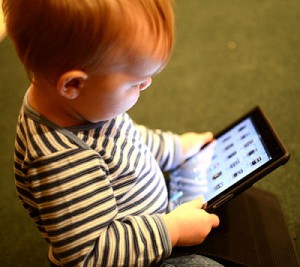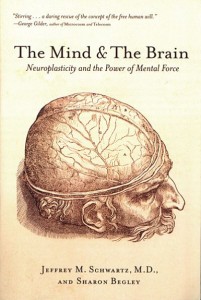The Power of Parental Example
[Even though I refer to the “mommy” mind meld, these principles apply to whomever are the two or three connected, nurturing adults in an infant’s life — father, grandmother, consistent (not rotating) caregiver.] 
Imitation is the young child’s primary form of learning, which is why one of my first bits of guidance to parents coming to me for counseling is to cut down by at least 50% the sheer number of words they say to their young child. Children learn from who we are and what we do far more than from what we say. And credible leaders don’t yammer on and on.
(Because example is indeed the most powerful mode of teaching and learning — not just for children but for humans in general – it is Principle #3 of the seven principles on which my book Parenting for Peace is based.)
But I digress. Let’s get to this exciting topic of…
The Mommy Mind Meld
One of the most powerful ways in which this parent-as-model process shapes your child’s optimal wellbeing is in the realm of actual brain development: the relatively new field of attachment neurobiology has revealed that our babies and  children actually piggyback on the self-regulation capacities of the limbic systems in our own brain! When you hold a distressed infant in your arms, the soothing she experiences doesn’t just come from your secure embrace, but also from the actual regulation and modulation of her aroused nervous system that happens when her immature social-emotional brain actually links up with your more mature one!
children actually piggyback on the self-regulation capacities of the limbic systems in our own brain! When you hold a distressed infant in your arms, the soothing she experiences doesn’t just come from your secure embrace, but also from the actual regulation and modulation of her aroused nervous system that happens when her immature social-emotional brain actually links up with your more mature one!
While the researchers use such terms as “biological synchronicity” and “limbic resonance,” the sci-fi image of “mind-melding” captures it well. Writes one researcher, in evident awe, “It is a biologically based communication system that involves individual organisms directly with one another: the individuals in spontaneous communication constitute literally a biological unit.”
But it gets even wilder than that, and has more far-reaching implications for your child’s lifelong wellbeing and success: over the days and months and years of such attuned, connected encounters, the circuitry of your baby’s social brain wires up to emulate yours! Attachment neurobiology pioneer Allan Schore puts it bluntly: “The mother is downloading emotion programs into the infant’s right brain. The child is using the output of the mother’s right hemisphere as a template for the imprinting, the hard wiring, of circuits in his own right hemisphere that will come to mediate his expanding affective capacities, an essential element of his emerging personality.”
What that means in plain English is that engaged, attuned, playful interactions with us are a basic and essential form of nourishment for our babies. Bruce Perry points out that developing brains require human interaction as fervently as caloric nutrition for their healthy growth! (For more on this, read the Mommy Mind Meld excerpt from “Parenting for Peace”.)
 What is NOT nourishing to the developing brain is “electronic engagement” — which is largely an oxymoron, as far as the social brain is concerned. I’m referring to Baby Einstein and other info-tainment, as well as data on the screens of iPhones, iPads, and lapware computers designed for babies. The Baby Einstein juggernaut bears commenting on, just in case you feel like the mom who said, “You want to make sure you’re doing everything you can for your child, and you know everyone else uses Baby Einstein, so you feel guilty if you don’t.” In case you missed it, in 2007 Baby Einstein, along with all other so-called educational screened programming, was found to be associated with *delayed* language development; television or video watching at this age, said an American Academy of Pediatrics spokesperson, “probably interferes with the crucial wiring being laid down in their brains during early development.”
What is NOT nourishing to the developing brain is “electronic engagement” — which is largely an oxymoron, as far as the social brain is concerned. I’m referring to Baby Einstein and other info-tainment, as well as data on the screens of iPhones, iPads, and lapware computers designed for babies. The Baby Einstein juggernaut bears commenting on, just in case you feel like the mom who said, “You want to make sure you’re doing everything you can for your child, and you know everyone else uses Baby Einstein, so you feel guilty if you don’t.” In case you missed it, in 2007 Baby Einstein, along with all other so-called educational screened programming, was found to be associated with *delayed* language development; television or video watching at this age, said an American Academy of Pediatrics spokesperson, “probably interferes with the crucial wiring being laid down in their brains during early development.”
The take-away is, our children wire up to be us ourselves, from the very beginning; this foundation then serves as their launching pad, at the most basic level of brain structure, for surpassing us into higher realms of accomplishment, social intelligence, and joyous self-mastery.
This post debuted on six wonderful parenting sites during my spring blog tour. To see some of the lively comments, questions and conversation the tour elicited, visit some of the tour stops, linked at the bottom. Your comments of course welcomed in perpetuity. (Full citations and references in the linked excerpt.)
The Power of Example (With a Miraculous Twist)
For this and many other reasons related to the potent teaching power of models, a fruitful question to ask yourself, ideally beginning even before you have a child, is “Am I worthy of my child’s unquestioning imitation?” Daunting, yes. But it’s best to realize early on that whether or not you can answer “Yes” to this question, what you see in the mirror is to a great extent what you will see in your child. And, most likely in your child as an adult.
But don’t despair: Nature seems to have built in a special mechanism that allows us to give our children a fighting chance to surpass us. If our children’s potential was constrained by the limitations of our own accomplishment, we’d be doomed! We’d have to wait until our sixties, seventies, eighties — or maybe never — before we’d feel prepared to be parents. Nature has brilliantly built into the system that our children most powerfully respond to our inner life; thus, it is the ideals, aspirations and earnest striving we engage in that greatly shapes them — our upward striving that helps Life, in theologian John Cobb’s words, to “exert its gentle pressure everywhere, encouraging each thing to become more than it is.”
Indeed, as I look back into my own history as a new mother, I recognize it quite starkly: if this mommy mind meld deal were merely a copy-and-paste situation, my son and my daughter wouldn’t have had much hope. Motherhood brought me to my knees, and it was many years before I recognized that I had suffered from what I’ve come to call CCPD — Chronic Covert Postpartum Depression. I had grief and rage bubbling up all over. It was really hard for me to be present.
But I never stopped striving — for insight, for healing, for wholeness. And that changed everything, and I believe it is why my son and daughter have both flourished into their early adulthood.
 So what does this miraculous striving look like day to day? Presence. Mindfulness. Renouncing multi-tasking in favor of uni-tasking. Being fully engaged with all of you in whatever you’re doing. UCLA psychiatrist and Buddhist meditator Jeffrey Schwartz discovered that mindfulness (the willful mastering of the flow of thoughts and feelings) could successfully treat serious OCD (obsessive-compulsive disorder) and writes in his amazing book “The Mind and the Brain,” “…the exertion of willful effort generates a physical force that has the power to change how the brain works and even its physical structure. The result is neuroplasticity.”
So what does this miraculous striving look like day to day? Presence. Mindfulness. Renouncing multi-tasking in favor of uni-tasking. Being fully engaged with all of you in whatever you’re doing. UCLA psychiatrist and Buddhist meditator Jeffrey Schwartz discovered that mindfulness (the willful mastering of the flow of thoughts and feelings) could successfully treat serious OCD (obsessive-compulsive disorder) and writes in his amazing book “The Mind and the Brain,” “…the exertion of willful effort generates a physical force that has the power to change how the brain works and even its physical structure. The result is neuroplasticity.”
This mental force that can change the brain, can certainly change the download of the mommy mind meld. What we hand down to our children as we parent is not simply a linear, one-for-one duplicate of ourselves, and that is where the stunning possibilities of parenting for peace lie: through refining our own consciousness we throw the door open on our children’s potential.
Where’s Your Head At?
All this fascinating neurobiology of attachment, including the Mommy Mind Meld, is why the “biggest bang” intervention you can make in your parenting skill set (i.e., one thing you can do that yields maximum benefit across multiple dimensions of your and your child’s wellbeing) is to begin cultivating your inner life, and mastery over the flow of your own thoughts. Meditation, yoga, mindfulness, contemplative prayer, journaling — these are all avenues by which to do this.
dimensions of your and your child’s wellbeing) is to begin cultivating your inner life, and mastery over the flow of your own thoughts. Meditation, yoga, mindfulness, contemplative prayer, journaling — these are all avenues by which to do this.
Engaging in a practice of gratitude is also a big-bang parenting tool, beginning as early as possible. Why? The fields of positive psychology and psychoneuroimmunology (mind-body science) have revealed gratitude as one of the most surefire ways to amp up your physical and emotional wellbeing. And epigenetics (which refers to the potent influence we have on whether certain genes we carry are expressed or not) shows us that we have far more power over our own selves and our own destinies than we ever before imagined. And a good deal of that power comes through the influence of our attitudes, our feelings and our perceptions. Here’s a handy list of seven ways to rewire a negative mindset** and move toward more gratitude at any time!
Nature’s Own Head Start Program
The reflection of our own inner lives in our children doesn’t wait till the mommy mind meld in infancy to begin. Pregnancy is Nature’s Head Start Program, when a baby’s organs and tissues, including the lifelong foundations of basic  brain infrastructure, develop in direct response to lessons they receive about the world — lessons that come from Mom’s diet, her behavior and her state of mind.
brain infrastructure, develop in direct response to lessons they receive about the world — lessons that come from Mom’s diet, her behavior and her state of mind.
It is Nature’s job to create organisms as well-suited as possible to their environment, so the unceasing question asked by the baby in the womb — which is answered chemically and energetically via the mother’s thoughts, feelings, behaviors (and of course nutrition) — is, What kind of world am I coming into, Mommy, through your eyes? Chronic, unremitting stress teaches the baby via Mom’s biochemistry that it’s a dangerous world out there, and foundational brain circuitry wires up to thrive in a dangerous world. (So if you had undue stress during pregnancy, and your infant startles easily, seems hyperreactive, cries a lot — or the converse, seems “zoned out” — is hard to soothe and settle, this can help you understand why. Bruce Perry explains this so well here. This isn’t about blame or guilt, but about the empowerment that comes with understanding. It’s never too late to harness neuroplasticity!)
I’m not suggesting anyone become a blandly response-free Stepford Mom — either before or after birth. Normal, occasional stresses are part of life and part of normal development, but I’m inviting pregnant moms to orient themselves toward a posture of holding a protective, buffering space of appreciation — one of my clients used an image of a crystalline, pink bubble for her baby when she was having a stressful day — so that your baby can flourish as robustly as possible.
And always keep in mind that during pregnancy and beyond, you are your child’s living example: your child’s biological mandate is to shape himself — including the intricate circuitry of his brain — to match the promise of the world you portray.
*******
By Marcy Axness, PhD, author of Parenting for Peace: Raising the Next Generation of Peacemakers
Some of the liveliest and thought-provoking discussion took place at Janet Lansbury’s blog and on Creating a Family (both of which ran the post in two parts).
Images (in order):
o5com under Creative Commons license
Lisa Pflaum Photography by permission
Cantabrigensis under Creative Commons license
Henriksent under Creative Commons license
Book cover, fair use
crucifixion cruise under Creative Commons license
DrDawn1 under Creative Commons license
**If you are already on the Parenting for Peace list and would like a copy of “7 Ways to Rewire a Negative Mindset,” feel free use the link and sign up so you can get the download; you will not be “double-listed”!
Tags: brain development, epigenetics, fetal brain development, interpersonal neurobiology, mindfulness, social intelligence, striving


